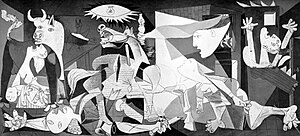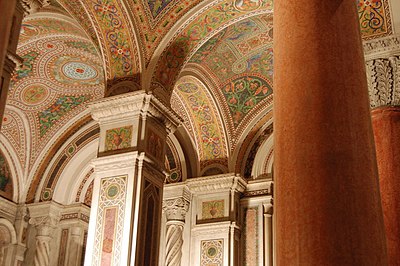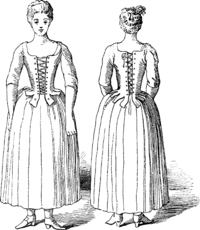From Wikipedia, the free encyclopedia

The Bath, a painting by Mary Cassatt (1844–1926).

Guernica by Pablo Picasso (1937) is considered a 20th century masterpiece.
Art refers to a diverse range of human activities and artifacts, and may be used to cover all or any of the arts, including music, literature and other forms. It is most often used to refer specifically to the visual arts, including mediums such as painting, sculpture, and printmaking. Aesthetics is the branch of philosophy which considers art.
Visual art is defined as the arrangement of colors, forms, or other elements "in a manner that affects the sense of beauty, specifically the production of the beautiful in a graphic or plastic medium".[1] The nature of art has been described by Richard Wollheim as "one of the most elusive of the traditional problems of human culture".[2] It has been defined as a vehicle for the expression or communication of emotions and ideas, a means for exploring and appreciating formal elements for their own sake, and as mimesis or representation.[3] Leo Tolstoy identified art as a use of indirect means to communicate from one person to another.[3] Benedetto Croce and R.G. Collingwood advanced the idealist view that art expresses emotions, and that the work of art therefore essentially exists in the mind of the creator.[4][5] Art as form has its roots in the philosophy of Immanuel Kant, and was developed in the early twentieth century by Roger Fry and Clive Bell.[3] Art as mimesis or representation has deep roots in the philosophy of Aristotle.[3]
Traditionally the term art was used to refer to any skill or mastery, a concept which altered during the Romantic period, when art came to be seen as "a special faculty of the human mind to be classified with religion and science".[6]
Generally art is a (product of) human activity, made with the intention of stimulating the human senses as well as the human mind; by transmitting emotions and/or ideas. Beyond this description, there is no general agreed-upon definition of art, since defining the boundaries of "art" is subjective, but the impetus for art is often called human creativity.[citation needed]
The evaluation of art has become especially problematic since the 20th century. Wollheim distinguishes three approaches: the Realist, whereby aesthetic quality is an absolute value independent of any human view, the Objectivist, whereby it is also an absolute value, but is dependent on general human experience, and the Relativist, whereby it is not an absolute value, but depends on, and varies with, the human experience of different humans.[7]
An object may be characterized by the intentions, or lack thereof, of its creator, regardless of its apparent purpose. A cup, which ostensibly can be used as a container, may be considered art if intended solely as an ornament, while a painting may be deemed craft if mass-produced. [citation needed]





